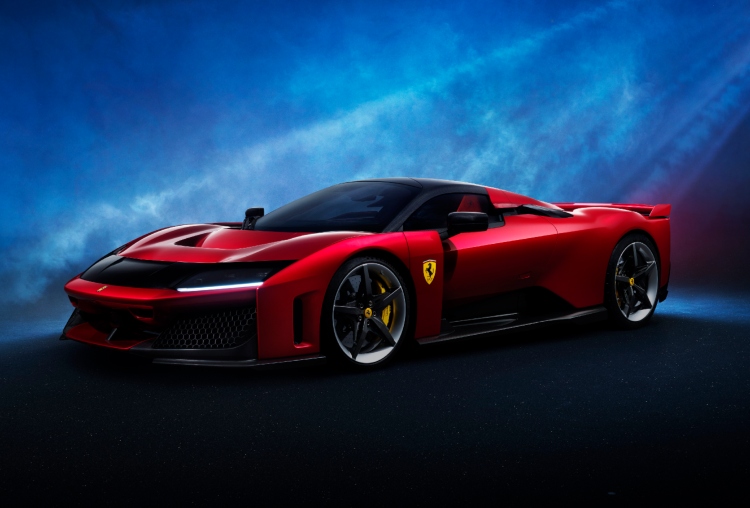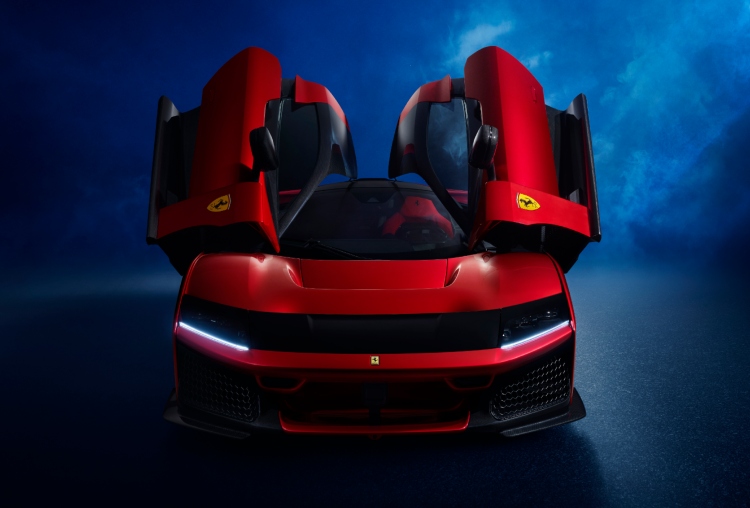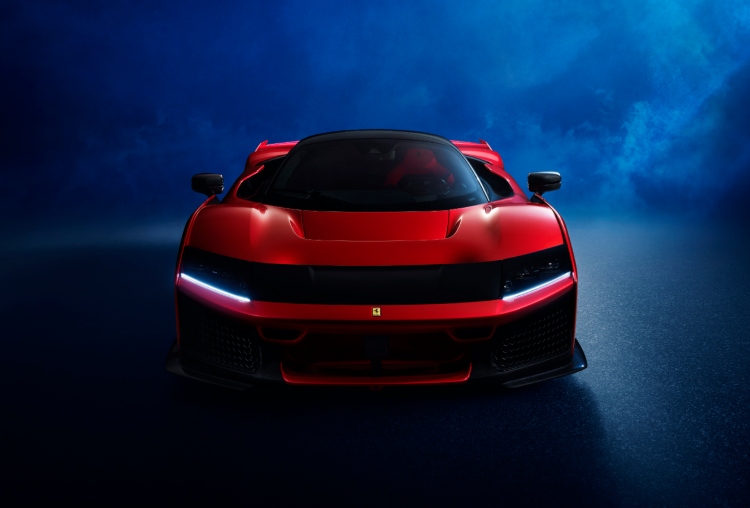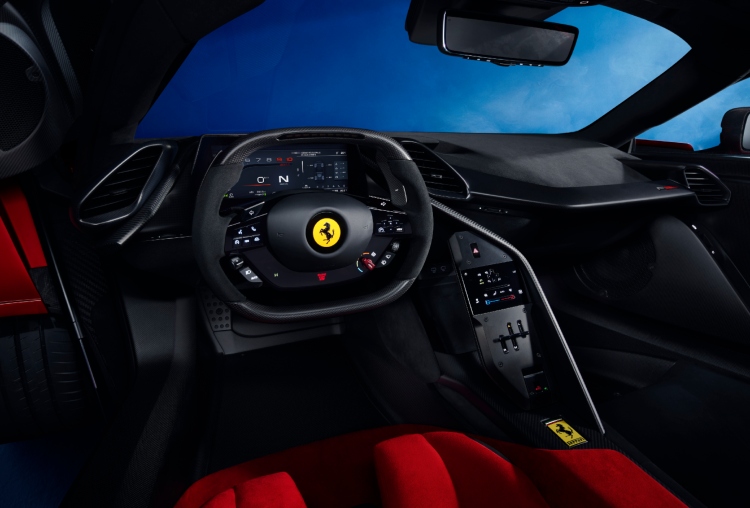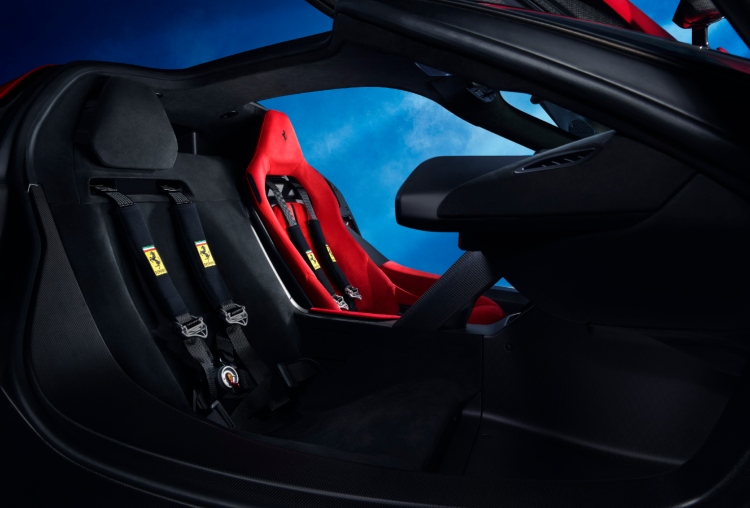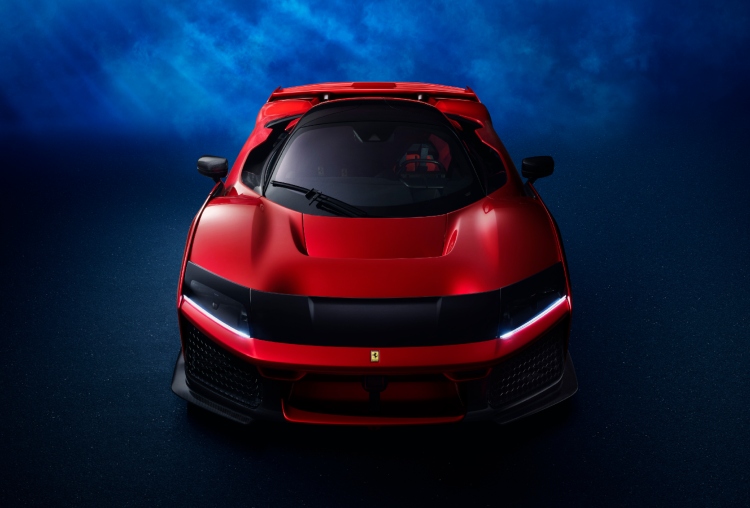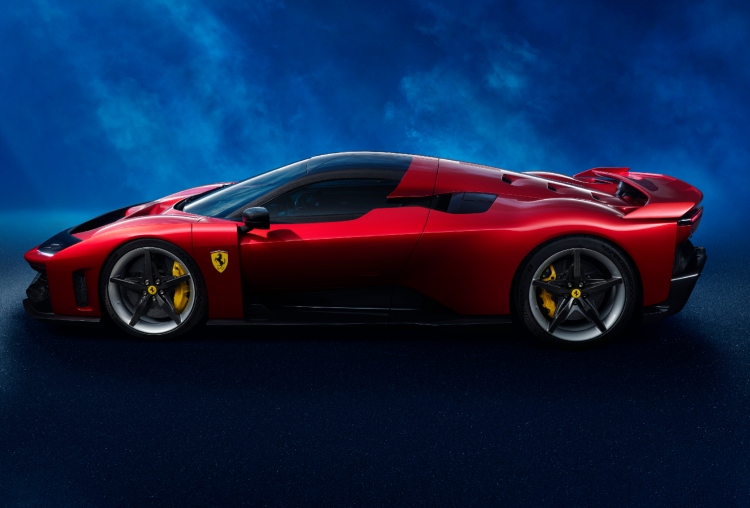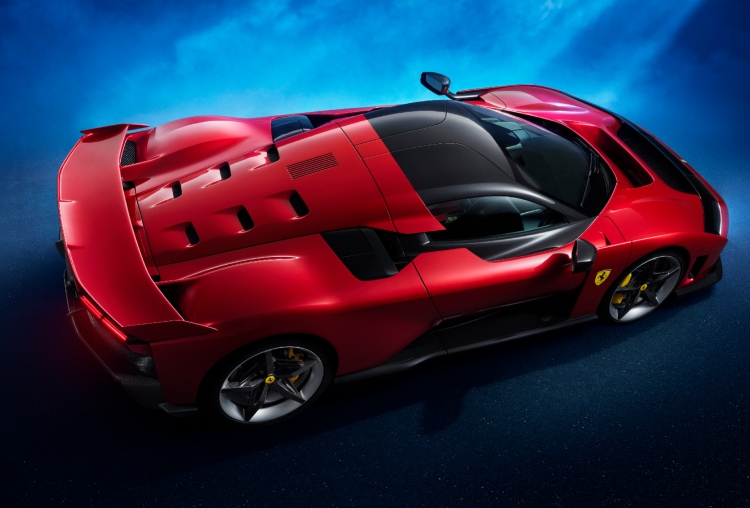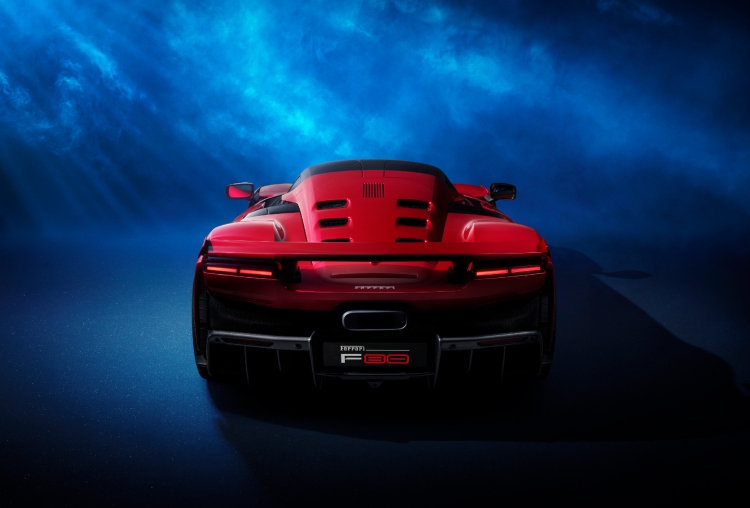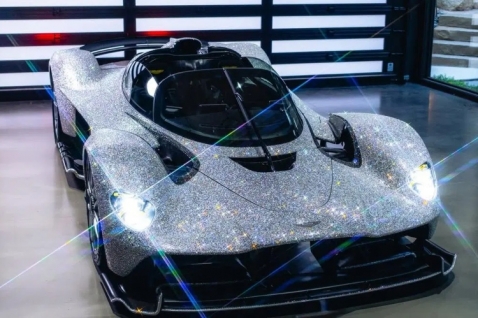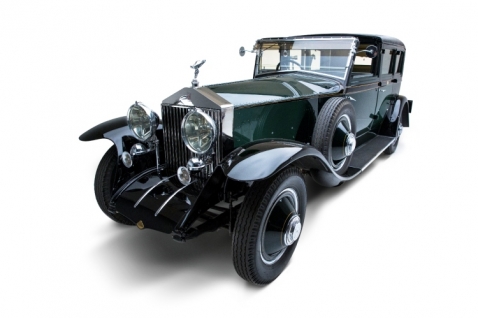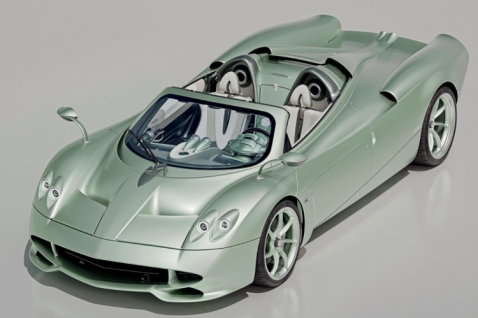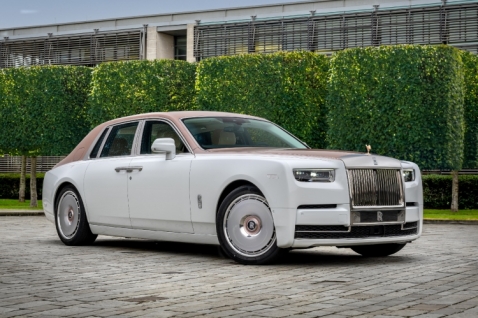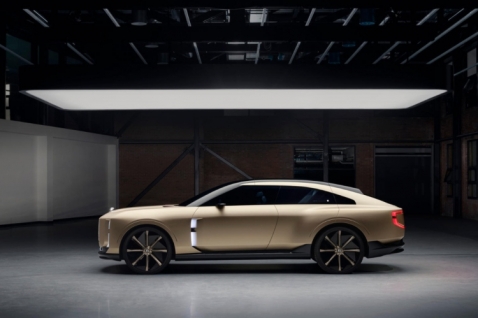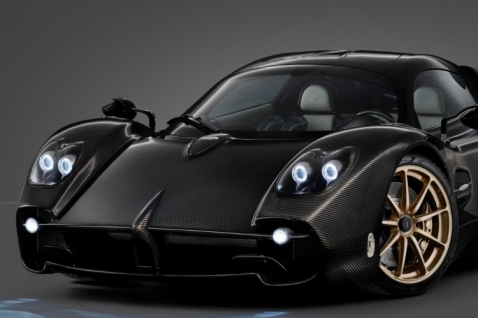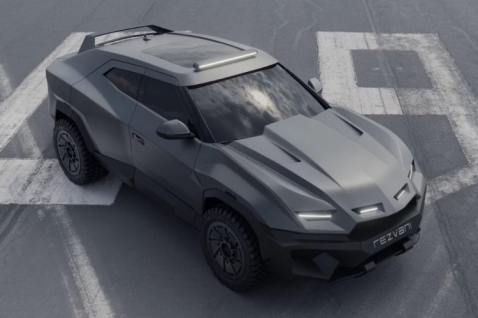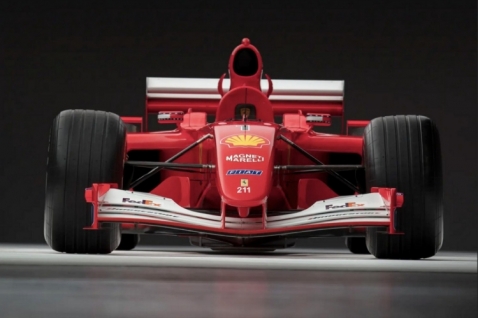More photos
Ferrari has just introduced the F80, and it has written a new chapter in the history of the legendary supercar with the Prancing Horse emblem.
The F80 will be produced in a limited series of only 799 units and will join the pantheon of icons such as the GTO, F40, and LaFerrari, showcasing the best that the Maranello brand has achieved in technology and performance.
Since 1984, Ferrari has occasionally launched a new supercar that represents the pinnacle of cutting-edge technology and innovation of its era and that is destined to become part of popular culture. Aimed at the most discerning clients of the brand, these cars have instantly become legends in their time, leaving an indelible mark not only on Ferrari's history but also on the history of automobiles.
The latest addition to this family, the F80, is tasked with representing the pinnacle of engineering for an internal combustion engine vehicle and utilizes all the most advanced technological solutions, including the latest generation of hybrid technology for the powertrain, to achieve unparalleled levels of power and torque. Every aspect of the architecture is designed to maximize performance, from the carbon fiber chassis to the extreme aerodynamic solutions that far surpass anything seen in street-legal cars, to the new active suspension optimized to allow the driver to extract maximum performance on the track.
Compared to anything else in the current world of supercars, the F80 combines all these attributes with uncompromising levels of usability on the road, where it can be easily driven. This ability shaped every decision regarding the technology and architecture to achieve what at first glance seems impossible: creating a track-oriented supercar that can be driven like a production model.
All of this means that the driver will spend even more time in the car and will truly get to know and enjoy its performance and thrilling driving experience. The F80's architecture is so extreme that the chosen layout results in narrower cabins with the driver as the center, yet it still offers excellent space and comfort for the passenger. This decision had key advantages in terms of minimizing drag and weight.
The cockpit space thus has a pronounced single-seater feel, despite the car being homologated for two people, resulting in an architecture that could be called "1+." The main reason for this decision was to minimize width, benefiting aerodynamics (less drag) and weight reduction. This concept perfectly aligns with the world of motorsport from which this car not only draws inspiration but also inherits technological solutions.
As has always been the case with Ferrari supercars before the F80, the powertrain is based on the best expression of motorsport technology. The GTO and F40 featured turbo V8 engines because Formula 1 cars used turbo engines in the 1980s. Today, both in Formula 1 and the World Endurance Championship (WEC), power units consist of turbo V6 internal combustion engines combined with an 800V hybrid system. Therefore, it was only natural that this architecture—the same used in the 499P, which achieved back-to-back victories at the 24 Hours of Le Mans—would be carried over into the new F80.
However, here the power unit is further enhanced with the introduction, for the first time in a Ferrari model, of electric turbocharger (e-turbo) technology. With an electric motor installed between the turbine and compressor of each turbo, this allows for an exceptional specific power output and instant response from low revs.
Aerodynamics play a key role in the F80, with solutions like the active rear wing, rear diffuser, flat underbody, front three-plane wing, and S-Duct working together to generate 1,000 kg of downforce at 250 km/h. This result is further enhanced by active suspension, which directly contributes to generating ground effect. Performance is also boosted by electric front axles, enabling all-wheel drive to better handle torque and power, as well as new brakes featuring CCM-R Plus technology, derived from motorsport.
As with all supercars before it, the F80 marks the beginning of a new design era for Ferrari, with a more taut and extreme design language emphasizing its racing soul. Clear references to elements borrowed from aviation highlight the advanced technology and elegant engineering of each technical solution. But there are also allusions to its sacred predecessors, clearly declaring the F80's illustrious heritage.
The internal combustion engine, a 120° V6 F163CF, is the pinnacle of Ferrari's six-cylinder engine development. This unit produces an astounding 900 hp, making it the Ferrari engine with the highest specific power output of all time (300 hp/liter), with the hybrid system's front electric axle (e-4WD) and rear motor (MGU-K) adding another 300 hp.
The connection to motorsport, and endurance racing in particular, is strong: the architecture of this engine and many of its components are closely derived from the 499P power unit, which has won the last two editions of the 24 Hours of Le Mans. Similarities with the car participating in the World Endurance Championship (WEC) include the architecture, casing, layout, and timing system drive chains, as well as the oil pump circuit, bearings, injectors, and GDI pumps.
Of course, there is also technology transferred from Formula 1, from which the F80 inherits the MGU-K concept (with the development of an industrially produced electric motor similar to the one used in Ferrari F1 cars) and the MGU-H (which generates energy from the excess kinetic energy of turbine rotation created by heat from exhaust gases), with a customized e-turbo application.
For maximum performance in all possible conditions, every aspect of engine calibration has been taken to an extreme level, focusing especially on ignition and injection timing, the number of injection events per stroke, and variable valve timing management. The F80 is equipped with the first Ferrari engine to use a new approach to knock control, allowing the engine to operate closer to the knock limit than ever before. This enables the use of higher combustion chamber pressures than ever before (+20% compared to the 296 GTB), unlocking even more potential from the engine.
Another key aspect was the work dedicated to dynamically calibrating the torque curve in each gear, a first for a Ferrari road car. This part of the project focused on real-world driving conditions and managing the e-turbo system, as the limits of knock and compressor surge vary depending on whether they are measured under dynamic or stationary conditions. As a result of this research, a dedicated calibration for each gear was developed, allowing the engine to achieve responsiveness comparable to an internal combustion engine under all operating conditions.
The e-turbines, with electric motors installed axially between the turbine and compressor housing, allow engineers to optimize the fluid dynamics of the engine for maximum power at mid-to-high engine speeds without the usual compromise that entails in terms of turbo lag at low revs. The introduction of electricity into this equation allows for the definition of e-turbo management strategies that eliminate turbo lag and ensure lightning-fast response.
The GDI system’s injectors, pressurized to 350 bar, are located centrally within the combustion chamber to optimize fuel-air mixing, while multiple injection strategies ensure extraordinary efficiency for remarkable performance with reduced emissions. The profiles of the intake and exhaust valves have been revised to optimize fluid dynamic efficiency and increase the maximum engine speed to 9,000 rpm, with a dynamic limit of 9,200 rpm.
Both the intake and exhaust ducts have been polished to improve performance; the intake ducts have been shortened to reduce resistance and cool the air-fuel mixture through fluid dynamic detonation and are specifically designed to increase turbulence in the combustion chamber. The exhaust duct complies with current emissions standards (Euro 6E-bis) but is already prepared for future global emission regulation evolutions.
The Inconel© exhaust manifolds are designed to minimize pressure losses and are tuned to emphasize the distinctive sound of the Ferrari V6 engine. The steel camshaft is made from a cast element and features forged cam rods with a 120° offset. The 1-6-3-4-2-5 firing order gives the F80 its typical Ferrari tone. To reduce weight, the webs and counterweights of the camshaft have been lightened.
The connecting rods and pistons have also been revised: titanium connecting rods feature a serrated interface between the rod and the large end cap to ensure perfect alignment between the two parts and absolute assembly precision with the bearings. The aluminum pistons have been optimized to reduce weight and withstand the higher pressures and thermal loads in the combustion chamber due to the extremely high torque and power output. Specifically, DLC (diamond-like carbon) coated steel was used for the piston pin. Additionally, an extra oil hole has been added in the zone between the piston pin and connecting rod to improve lubrication.
To lower the car's center of gravity, the engine is installed as close as physically possible to the flat underbody. As a result, none of the components housed at the bottom of the oil sump extend more than 100 mm below the central camshaft axis. It was also decided to tilt the engine-gearbox unit by 1.3° along the Z-axis, raising the gearbox without compromising the aerodynamic efficiency of the flat underbody.
To reduce engine weight, the cylinder housing, camshaft housing, distributor cover, and other components have been revised, while titanium bolts have also been used. As a result of these measures, the engine weighs no more than the V6 model in the 296 GTB despite the power increase of 237 hp.
The lowered installation position of the engine-gearbox unit was made possible by a new smaller flywheel diameter, conceived and designed from scratch for this application. This innovative solution was enabled by using two sets of springs, which also contributed to reducing the system’s overall stiffness and more effectively filtering vibrations transmitted to the gearbox. A damper was also developed specifically for this application to absorb the higher torsional vibration forces in the powertrain and handle more heat stress due to increased performance.
The electric motors used in the F80 are the first devices developed, tested, and manufactured entirely by Ferrari in Maranello, with the specific goal of maximizing performance and minimizing weight. Their design (with two motors on the front axle and one on the rear of the car) directly stems from Ferrari’s racing experience; in particular, the stator and rotor in the Halbach array configuration (which uses a special distribution of magnets to maximize the strength of the magnetic field) and the carbon fiber magnet sleeve are all solutions derived from the MGU-K unit used in Formula 1.
The rotor adopts Halbach array technology to maximize magnetic flux density and minimize weight and inertia. The carbon fiber magnet sleeve, on the other hand, is used to increase the motor’s maximum speed to 30,000 rpm. The stator with concentrated windings reduces the weight of the copper used for end windings, while Litz wire minimizes high-frequency losses. Litz consists of multiple insulated strands instead of a single wire, reducing the "skin effect" and allowing current to be evenly distributed across the entire cross-section to minimize losses. Resin covering all active stator parts improves heat dissipation.
The DC/DC converter transforms direct current at one voltage into direct current at another. This innovative technology allows a single component to handle three different voltages simultaneously: 800V, 48V, and 12V.
Using direct current produced by the high-voltage battery at 800V, the Ferrari converter generates direct current at 48V to power the active suspension and e-turbo systems, as well as 12V direct current to power the vehicle's electronic control units and all other electrical accessories. Innovative resonant technology allows this component to convert power with no latency and over 98% conversion efficiency, enabling it to act as an accumulator. This component has eliminated the need for a 48V battery, reducing weight and simplifying the configuration of the electrical system.
Also fully developed and manufactured by Ferrari, the front axle includes two electric motors, an inverter, and an integrated cooling system. This component allows for torque vectoring on the front axle. The integration of different functions into a single component and a new mechanical configuration resulted in a weight saving of about 14 kg compared to previous applications, with the entire component weighing only 61.5 kg. Optimizing mechanical efficiency was the primary goal: low-viscosity oil (Shell E6+) and an active lubrication system with an oil tank integrated directly into the axle reduced mechanical power losses by 20%. The use of high-contact-ratio gears (HCR) contributes to reducing noise by 10 dB.
The direct current received from the high-voltage battery is converted into the alternating current required to power the electric motor via an inverter. The inverter integrated into the front axle is bidirectional, meaning it also converts the alternating current produced by the axle during regenerative braking into direct current to recharge the battery. The inverter used for power conversion and managing the two front motors is capable of delivering a total of 210 kW of power to the axle. On the F80, the inverter is integrated directly into the axle and weighs just 9 kg, contributing to the weight reduction of this component compared to its counterpart on the SF90 Stradale.
Another inverter is used for the rear electric motor (MGU-K). This unit performs three functions: starting the internal combustion engine, recovering energy to charge the high-voltage battery, and providing additional torque assistance to the engine under certain dynamic conditions. It can generate up to 70 kW in regenerative mode and assists the internal combustion engine with up to 60 kW of power. Integrated into these two inverters is the Ferrari Power Pack (FPP) system, a power module that combines all the elements needed for power conversion into the most compact possible unit. This unit consists of six modules of silicon carbide (SiC) control boards and a dedicated cooling system.
The heart of the energy accumulation system—the high-voltage battery—has been designed for very high power density. The innovative battery design is based on three principles: the lithium cell chemistry derived from Formula 1, extensive use of carbon fiber for the construction of the monocoque case, and the patented design and assembly method (cell-to-pack), which minimizes the weight and volume of the unit. Positioned low in the engine, the battery further improves the vehicle's dynamic behavior by lowering the car's center of gravity. All electrical and hydraulic connectors are integrated into the component to reduce cable and hose length, while the pack is configured with 204 cells connected in series, equally divided into 3 modules, with a total energy capacity of 2.3 kWh and a maximum power output of 242 kW.
Lastly, to improve integration between the internal electric and electronic components, Ferrari developed the CSC (Cell Sensing Circuit) wireless sensor, which monitors cell voltage using spring contacts and measures the temperature of the cells via infrared sensors.
The F80 pushes aerodynamic performance to levels never before seen in a Ferrari road car, as evidenced by the 1000 kg of downforce generated at 250 km/h. This astonishing feat was achieved through the perfect synergy of all Ferrari's internal departments working on defining the car's architecture. For every department, the perfect balance between downforce and top speed was the basis for every design decision, shaping a series of extreme solutions befitting a true supercar.
The front of the F80, which develops 460 kg of total downforce at 250 km/h, is inspired by aerodynamic concepts used in Formula 1 and the World Endurance Championship (WEC), innovatively reinterpreted for this application to become the cornerstone of the entire design. On one hand, the inclined driver position allowed for a high central spine chassis, while on the other, the cooling system arrangement freed up the entire central zone of the vehicle, maximizing usable space for other functions.
The central volume of the car's front acts as a large main element of the front wing. The interior of the S-Duct contains two winglets that follow the main profile to complete the triplane wing configuration, with curves and vents clearly inspired by the 499P. Key to the aerodynamic efficiency of the car's front is how the triplane integrates with the S-Duct and high central spine, minimizing blockage of the airflow to the wing and maximizing performance.
As a result, the airflow from the underbody and bumper undergoes a rapid vertical expansion and is diverted inside channels toward the front hood, creating a powerful lifting effect that generates a strong low-pressure zone beneath the underbody. This contributes to 150 of the 460 kg of maximum downforce generated at the front of the car, though it is highly sensitive to changes in ride height. The car's aerodynamic balance is ensured by the active suspension, which controls the vehicle’s stance in real-time and adjusts the distance between the underbody and the ground depending on driving conditions.
Furthermore, the space freed up under the driver’s legs allowed for additional room for three pairs of bargeboards. These devices generate powerful, concentrated vortices that introduce a speed component into the airflow toward the diffuser exit. In addition to enhancing the underbody's suction power, the exit also reduces blockage and improves the performance of the front triplane. The bargeboards also help mitigate the detrimental effects of airflow around the front wheel by restricting it and keeping it away from the underbody, preventing contamination of the airflow directed toward the rear of the car.
The aerodynamic performance of the car’s rear zone, which generates the remaining 590 kg of downforce at 250 km/h, is the result of the combined operation of the rear wing-diffuser system. The efficiency of this system depends on the amount of downforce generated by the underbody, as it has very little impact on drag.
To bring the diffuser performance of the F80 to extreme levels, the expansion space of the diffuser itself was maximized by tilting the engine-gearbox unit by 1.3° along the Z-axis, as well as configuring the rear chassis and suspension components. The starting point of the diffuser’s upward curvature was moved forward, resulting in a diffuser with a record-breaking length of 1800 mm, generating a massive low-pressure zone beneath the vehicle, which in turn draws powerful airflow into the underbody.
The chassis geometry, with narrow, curved sides, contributes to creating an aerodynamic seal effect around the underbody by forming a channel that captures airflow adhering to the side and directs the air into the interior of the rear wheel housing beneath the rear suspension. The interaction between this airflow and the outer side of the diffuser disrupts vortices generated in the wheel-road contact zone, preventing air from entering the diffuser too far forward.
These solutions work in such perfect harmony that the downforce generated by the diffuser alone is 285 kg, more than 50% of the total at the rear axle.
The active rear wing is the most visible aero feature of the F80, completing the entire aerodynamic concept of the vehicle. The wing actuator system not only adjusts its height but also dynamically controls the angle of attack, allowing for precisely modulated downforce and drag. In the High Downforce (HD) configuration, used during braking, corner entry, and rotation, the wing takes on an angle of 11° relative to the airflow direction to generate over 180 kg of downforce at 250 km/h.
At the extreme opposite end of its rotational range, the wing is in the Low Drag (LD) configuration, with the leading edge raised. Drag is significantly reduced in this configuration, not only because of the reduction in lift but also due to the traction force generated by the residual low-pressure zone acting on the underside of the wing itself.
The rear wing is a key part of the entire adaptive aero system, allowing the F80 to adapt to all possible dynamic conditions, which are monitored and evaluated in real-time by the vehicle’s control systems. In response to the driver's demands for acceleration, speed, and steering angle, the system determines the optimal combination of downforce, aerodynamic balance, and drag, and instructs the active suspension and active aero systems to implement the ideal stance accordingly. For the aero system, this means controlling the angle of attack of the rear wing and the active Gurney wing state beneath the front triplane.
With two different configurations, the wing also allows control over the front downforce and drag of the car: the closed position generates maximum downforce, while in the open position, the device is oriented perpendicular to the airflow, and, similar to how DRS systems work in Formula 1, the lower section reduces drag and allows the car to achieve a higher top speed.
Defining the cooling system arrangement required in-depth studies and careful development to reconcile the thermal demands of the engine (which must dissipate over 200 kW of thermal energy during high-performance use) and the new hybrid system with aerodynamic demands. The goal was to design a cooling system with minimal impact on overall packaging, to achieve a functional and aerodynamically valid configuration that perfectly meets both the aerodynamic and thermal requirements of the F80.
The radiators are optimally positioned to maximize the flow of cold air and minimize interference with the hot airflow, ensuring better thermal exchange efficiency. Several other innovative solutions were also adopted to improve the car’s overall thermal balance, such as the transparent film integrated into the windshield, which uses energy from the 48V circuit to defog the glass and reduce the energy demand on the HVAC system. Additionally, the climate control system is regulated by electric valves that modulate refrigerant flow in line with the high-voltage battery circuit’s needs, enhancing energy management.
At the front, there are two condensers serving the climate control, battery, and active suspension systems, plus three high-temperature radiators for cooling the V6 engine. Two of them are placed laterally, in external positions, to make the most efficient use of the space between the underbody and the headlights, while the third is located centrally and uses the lift effect generated by the triplane to ensure adequate airflow.
Ventilation of hot air currents is optimized so as not to interfere with the front aerodynamics and cooling currents directed toward the rear of the vehicle. The main vent for the side radiators opens inside the rear wheel housing, a solution offering the least possible obstruction to provide excellent throughput for the radiators. Another vent located in the bumper zone at the front contributes to collecting thermal air while also directing hot air around the outside of the wheel. The central radiator releases heat into the zone between the bumper and the front bonnet without disrupting the airflow from the S-Duct exit.
Several different functions are integrated into the side of the F80 in a single formal solution described by the upper volume of the door, where the surface gradually drops to shape a channel integrated into the body itself. The shape of this channel protects the airflow along the fender from heat contamination by hot air currents from the front wheel and directs it along the surface of the door to the intake on the front side. This intake is topped by a wing that reinterprets the iconic shape of the NACA ducts: a solution that uses air vortices to capture a portion of the airflow moving in the region above the channel. Inside the channel, the incoming air is split into two flows, with one supplying the engine’s intake system, gaining up to 5 hp of additional power from the ram effect, while the other supplies the intercoolers that cool the intake air and the rear brakes.
Here, too, engineers decided on innovative solutions to keep the braking system—developed around the latest CCM-R Plus discs—functioning in optimal thermal conditions. These solutions include a front duct that uses the inner cavities of the long front impact dampers to channel cold airflow from the bumper to the discs, pads, and calipers, which are the most sensitive elements of the system. For the first time, this solution, patented by Ferrari, turns what was once a packaging issue into a means of maximizing cooling performance, delivering a 20% increase in cold air flow compared to the LaFerrari without penalizing the front-end aerodynamics.
The F80 is equipped with the most advanced set of technological solutions currently available to manage vehicle dynamics under all possible road and track conditions. Ferrari’s active suspension system is undoubtedly one of the showpieces of these and has been entirely re-engineered compared to the version used on the Ferrari Purosangue to adapt it to the F80’s supercar soul.
The system has fully independent suspension all around, powered by four 48V electric motors, double control, active internal dampers, and upper control arms created using 3D printing and additive manufacturing technology, used here for the first time on a Ferrari road car. This solution offers numerous advantages, such as optimized layout, more precise wheel control, reduced unsprung mass, no need for anti-roll bars, and the introduction of a camber correction function.
This system fulfills two seemingly irreconcilable demands—the need for a very flat ride on the track, where ride height changes must be minimized, and the need for comfort that effectively absorbs bumps on road surfaces during normal driving. This means that the car has extraordinary drivability on the road and can also optimize downforce under all possible conditions.
At low speeds, the system prioritizes mechanical balance and center of gravity control, while as speed increases, the ride height control system works to optimize aerodynamic balance in every different cornering situation, in accordance with the active aero system. When braking hard, such as when entering a corner, the ride height control minimizes changes to prevent instability caused by weight transfer to the front that typically occurs in this scenario. During cornering, the system contributes to increasing downforce to maintain optimal balance. When the car exits the corner, the system counteracts the tendency for the balance to shift to the rear, maintaining the best possible traction conditions on all four wheels and ensuring stability.
Another major evolution introduced by the F80 is the new SSC 9.0 (Side Slip Control) system, which now uses an integrated FIVE (Ferrari Integrated Vehicle Estimator) function. The new estimator is based on the concept of a digital twin, a mathematical model that uses parameters collected by the car’s sensors to virtually replicate its behavior.
In addition to estimating the slip angle in real-time, which was already possible with the previous generation, the new system also estimates the vehicle's central mass velocity, calculating both with a precision of less than 1° and 1 km/h respectively. The new estimator improves the performance of all the dynamic control systems onboard the vehicle, including traction control, for example.
Featuring the eManettino, like all PHEV Ferrari models, the hybrid powertrain of the F80 offers three different driving modes: ‘Hybrid’, ‘Performance’, and ‘Qualify’. There is no eDrive mode, available on the SF90 Stradale and 296 GTB, as the F80 cannot be driven in fully electric mode, which was deemed unsuitable for the car’s mission.
The ‘Hybrid’ mode is the default when the vehicle is turned on and enables all the functions designed to maximize the car’s efficiency and usability under all real-world conditions. This mode prioritizes energy recovery and maintaining the battery’s state of charge to prolong the MGU-K motor’s ability to deliver a boost when needed. The ‘Performance’ mode is oriented towards providing continuous performance levels during extended stints on the track, optimizing energy flow to the battery to always maintain a state of charge around 70%. The most extreme performance mode, ‘Qualify’, allows the driver to unleash all the power that the F80 has at its disposal, using electronic torque shaping during gear transitions at the rev limit to best combine the torque curves of the electric motor and internal combustion engine for maximum performance.
The ‘Performance’ and ‘Qualify’ eManettino modes also give the driver access to a completely new function that marks a first, not only for Ferrari but also for the automotive sector as a whole: Boost Optimization, a technology that memorizes the track on which the vehicle is driving and delivers additional power where it is most needed. After selecting this function, the driver first drives a reconnaissance lap during which the system identifies the track’s corners and straights, gathering the data needed to optimize power delivery. Once this lap is complete, the vehicle is ready to automatically deliver extra power when required, with no further action needed by the driver. How Boost Optimization is implemented depends on whether it is used in the ‘Performance’ mode—where it maintains consistently available performance for as long as possible—or the ‘Qualify’ mode, where it maximizes boost zones, even at the expense of the high-voltage battery’s state of charge.
The braking system of the F80 introduces another important innovation: CCM-R Plus technology, developed in collaboration with Brembo. The adoption of materials and technologies derived directly from Ferrari’s motorsport experience has shaped a product with exceptionally superior performance compared to any other road-going carbon-ceramic system.
CCM-R Plus uses longer carbon fibers to significantly improve mechanical strength (+100%) and thermal conductivity (+300%) compared to the previous generation solution. The braking surfaces are coated with a layer of silicon carbide (SiC), providing incredible wear resistance while also reducing bedding-in time. These discs work in conjunction with brake pads featuring a new compound that ensures an exceptionally consistent friction coefficient even during extended extreme use on the track. The larger heat exchange surfaces of the discs’ two ventilation channel rows, and their geometry, derived from F1 applications and optimized through advanced computational fluid dynamics (CFD) methods, ensure superior cooling.
Two tire choices, the Pilot Sport Cup2 and Pilot Sport Cup2R variants, both offered in sizes 285/30 R20 and 345/30 R21 (front/rear), were jointly developed with Michelin for the F80. The Pilot Sport Cup2 tires have a casing and tread design specifically created to deliver an exciting driving experience and maximize the car’s usability, while the Pilot Sport Cup2R uses specific compounds derived from motorsport applications to allow the car to reach previously unimaginable levels of track performance for a Ferrari road car in terms of maximum grip and consistency over time.
To maximize everyday usability, even when not driving at the limit, the F80 also comes as standard with all the main ADAS (Advanced Driver Assistance System) functions currently available: adaptive cruise control with Stop&Go function, automatic emergency braking, lane departure warning, lane-keeping assist, automatic high beams, traffic sign recognition, and driver attention alert.
The construction and other elements of the F80’s chassis were developed using a multi-material approach, where the most suitable material is used for each specific zone. The roof and the entire chassis are made of carbon fiber and other composites, while the front and rear subframes are made of aluminum and are attached with titanium bolts. At the rear, there is an additional aluminum subframe, attached to the main rear subframe with bolts, to carry the battery.
The subframes consist of closed extrusions connected to one another by cast elements. The chassis contains hollow side panels made of carbon fiber that serve as the main load-bearing elements. The roof is made of carbon fiber, produced, and then molded in a single autoclave session. Both areas use twin-walled tubes with blistering, an innovative production method derived from Formula 1. The chassis and roof use internal carbon fiber and Rohacell/Nomex sandwich panels as load-bearing structures.
As on the LaFerrari, the side sections act as impact absorbers for lateral collisions. The asymmetrical layout of the cabin allowed each side of the chassis to be optimized separately: the driver’s side has an adjustable seat, with a wide range of positions ensuring comfort and safety in the event of a side impact. This required more structural panels in the floor and longer impact absorbers on the driver’s side than on the passenger side, where a fixed seat is used to save weight while ensuring uncompromised safety for both occupants.
The front aluminum impact absorbers also contribute to thermal management, as their hollow interiors are used as ducts for cooling the braking system. Ferrari co-developed a new casting solution that reduced the previously applied minimum wall thickness for these castings (2.0 mm) by 23%. This, in turn, resulted in a 5% weight saving and a 50% increase in torsional strength compared to the LaFerrari. NVH (noise, vibration, and harshness) was also significantly improved to offer the most comfortable driving experience.
The body of the F80 is entirely new and made from pre-preg carbon fiber, molded in an autoclave using technology derived from Formula 1 and other motorsports. The front bonnet integrates the S-Duct, which consists of a fixed element connecting the two front wings.
Butterfly doors, as on the LaFerrari, are used, featuring a dual-axis rotation mechanism that allows them to open vertically to an angle of almost 90°. The substructure of the doors, a structural element that also absorbs dynamic loads in the event of a side impact, is constructed from special high-performance carbon fiber.
The rear engine cover, which echoes the stylistic hints of the doors in the side view, features six vents that channel hot air from the V6 engine and a grille that also vents the air.
The F80 is the result of a creative design study that led Ferrari’s Styling Center team, headed by Flavio Manzoni, to radically redefine the brand’s visual language, establishing a link between Ferrari’s past and future design. With the goal of assimilating a wide range of different elements of Ferrari’s design language and brand DNA, the study first drew attention to the aesthetics of Ferrari’s F1 racing cars to identify a direction for creating a car with a modern and innovative visual identity capable of housing both the driver and a passenger, while still offering an uncompromising single-seater experience.
With this logic as the foundation, the design of the F80 was then developed with technological insights, giving the car its bold, futuristic characterization. The ambitious performance targets required a holistic approach to the project; as a result, the formal design of the F80 project evolved from start to finish, with the Styling Center working in constant synergy with the engineering, aerodynamics, and ergonomics departments. From the very first sketches and abstract early form studies, the project evolved in a process of natural convergence to achieve the perfect balance between form and volume that visually expresses the uncompromised performance of the car.
The F80 has a powerful futuristic visual impact with distinct references to aviation. The architecture is defined by a dihedral cross-section with two lower angles firmly planted on the wheels. From the side view, the rear of the car has a sculptural flow that emphasizes the muscularity of the entire rear wing. The front of the car is defined by architectural elements: the wheel ends in a vertical panel that proudly rises above the doors, paying homage to the visual language of the F40.
Above the volume of the underbody rises the cabin, with its “floating dome” structure. The unusual shapes are the result of precise study of architecture and proportions. Sitting 50 mm lower than the LaFerrari’s roofline, the cabin has a significant impact on the perception of volume, broadening the car’s shoulders to make the cockpit appear even more compact.
As with all of Ferrari’s new-generation cars, the contrast between the upper body-colored zone and the lower zone of clear-coated carbon fiber emphasizes the design of the car, revealing more of its technical aspects with every new angle. The designers wanted to avoid an anthropomorphic effect on the front of the F80; the headlights are hidden in the visor element, a black screen that serves both aerodynamic and lighting functions, giving the F80 an especially original appearance.
The short rear of the car has two different configurations during use: with the movable wing folded or deployed. The rear lights are housed in a double structure consisting of the rear fascia and spoiler, creating a sandwich effect that gives the rear an extremely sporty character in both configurations.
When the rear wing is deployed, the car expresses even more power and dynamism, as the difference in visual balance between the two configurations reveals another side of its character. The functional needs of the car are visually resolved in the design to create a perfect dialogue between performance and form. Some of these functional characteristics play a very strong role in defining the car’s visual character: the NACA duct that directs air to the engine intake and the lateral radiators, for example, is as iconic as it is functional and forms one of the most original styling cues of the car’s side profile.
Another functional but highly symbolic element is the gridded engine cover, where six vents, one for each cylinder of the internal combustion engine, create an unexpected connection between the geometric lines and the car’s sculptural surfaces.
The compact proportions of the cabin were made possible by the choice of a single-seater-inspired cockpit, creating a visual perception reminiscent of a closed Ferrari F1 car. The long development process, involving designers, engineers, ergonomics specialists, and color and trim experts, culminates in an original new solution that clearly positions the driver as the protagonist in the cabin and transforms the car into a “1+1.”

